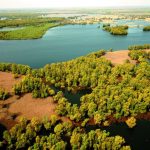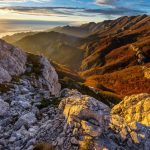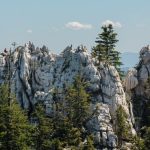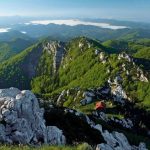There is a location in Croatia that can claim the title of a sailing tourists’ dream come true. It is the Kornati archipelago in central Dalmatia!
- Welcome!
- Where are the Kornati archipelago and Kornati National Park?
- How to get to Kornati and get around
- 5 things not to miss
- Tickets, fees and entrance to the Kornati National Park
- Where to stay?
- Where to eat?
- 3 things you should know about Kornati
Welcome!
George Bernard Shaw, a Nobel-prize winning playwright and activist, visited Croatia and Kornati in 1929. Of his visit, he wrote: “On the last day of the Creation, God desired to crown his work and thus created the Kornati islands out of tears, stars and breath.”
Of course, a quote like that will be used forever to attract visitors to this amazing location, but even if G. B. Shaw hadn’t helped, many visitors would be wowed by the amazing nature and evidence of human perseverance on this remarkable landscape.
Where are the Kornati archipelago and Kornati National Park?
The Kornati archipelago is a group of islands and islets located in the Šibenik-Knin County. The islands are almost equidistant from Šibenik and Zadar in Northern Dalmatia.
The archipelago consists of 149 islands, islets, and rocks, which can be divided into two groups: The Upper Kornati and the Lower Kornati. Upper Kornati (Gornji Kornati in Croatian; a yellow circle on the map), the island group around the island of Žut, protected as a significant landscape. The Lower Kornati (Donji Kornati) are the islets closer to the Kornat island, marked red on the map. They are closer to the open sea and most of that area is included in Kornati National Park.
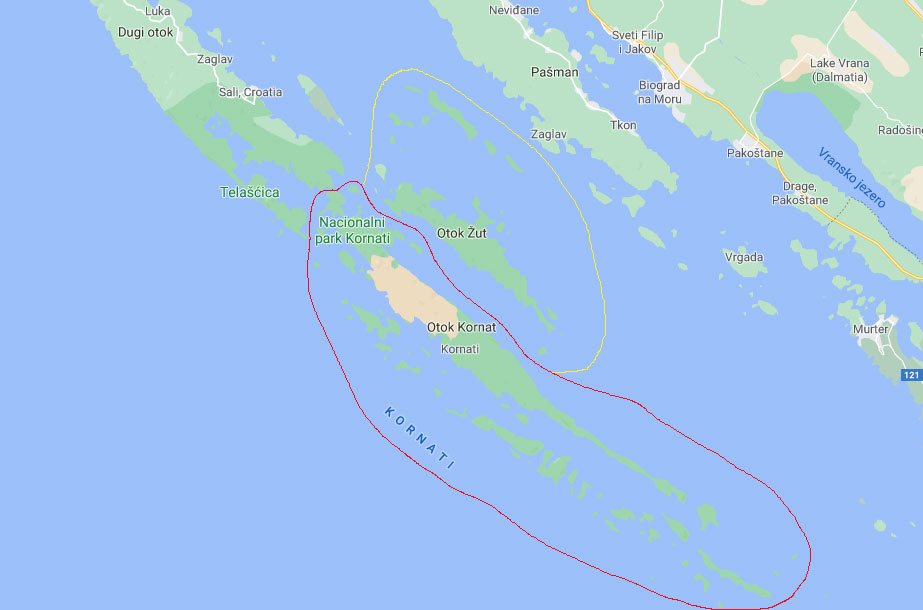
Kornati National Park was inaugurated in 1980 and consists of 89 islands and islets. It covers 220 square kilometers, a quarter of which is land, while the remaining three quarters are the protected marine ecosystem.
To the north of the National Park Kornati is Telašćica Nature park. That’s where you’ll find the steepest white cliffs diving into the Adriatic sea, and one of the deepest and safest bays on the Adriatic.
What about those names?
“Kornat” is one of the islands in the archipelago, and the largest one. The entire group of islands is named after that one island. “Kornati” is plural, in English it would be “the Kornats”, similar to Florida Keys. That’s why, when referring to the entire group of island, Kornati, we use the plural.
(REI’s roll-up hiking pants were, in fact, named after Croatian Kornati. If you’re looking for those pants, click here, but please, read a bit more about the archipelago as well!)
How to get to Kornati and get around
Boat
Obviously, to get to any archipelago, you will need to be on some type of boat. The Kornati islands are a major destination for nautical tourists. There is one ACI Marina within the National Park Kornati, ACI Piškera on Piškera island. On Žut island, outside the National Park, is another marina: ACI Žut.
ACI Jezera is on Murter, quite close to Kornati (around 10 nautical miles). Google will also helpfully tell you that there is a “Marina Kornati” in Croatia. Unfortunately, it’s NOT on Kornati. Rather, it’s in Biograd na Moru. Biograd na Moru is the coastal town closest to Kornati, so it is the logical gateway for most travellers coming to Kornati from the mainland.
There are no official marinas on Kornat Island itself. You will, however, be able to dock in many locations. Most restaurants and other places of interest will have their jetties or buoys for their guests.
Plane
If you want to fly as close as possible to the Kornati archipelago, you basically have two options: Zadar Airport and Split Airport. Zadar is much closer and is probably the most convenient. However, Split has more connections during the season and is still close enough to be an access point to Kornati.
Road
If you’re travelling around Croatia in a car, there are ways for you to visit Kornati. Almost all of the Norther-Dalmatian towns will be a good destination for you. Zadar, Murter, Kukljuca, Pakoštane, Trogir, Šibenik, Primošten, Pirovac, and Vodice are the locations where you’ll be able to find a day excursion to the Kornati National Park. To see the list of those providers, visit the National Park website.
5 things not to miss in the Kornati archipelago
Sailing
The Kornati are a sailor’s paradise. They offer everything a guest on a sailboat might want to find in one location: amazing locations to moor and dock for swimming and other sea activities, remarkable views from the sea, safety in many, many bays and coves during potential bad weather, excellent food in the restaurants on the islands and stuff to do and discover on them.
Coming to Kornati on a sailboat is probably the perfect way to enjoy the archipelago and the National Park. If you have the opportunity to sail around Kornati, make sure you take it as it is one of the very special experience you might have in Croatia!

There are 16 well-defined locations where you can spend the night moored in the National Park. These are marked on the map above with a little boat symbol.
Dry Stone Walls
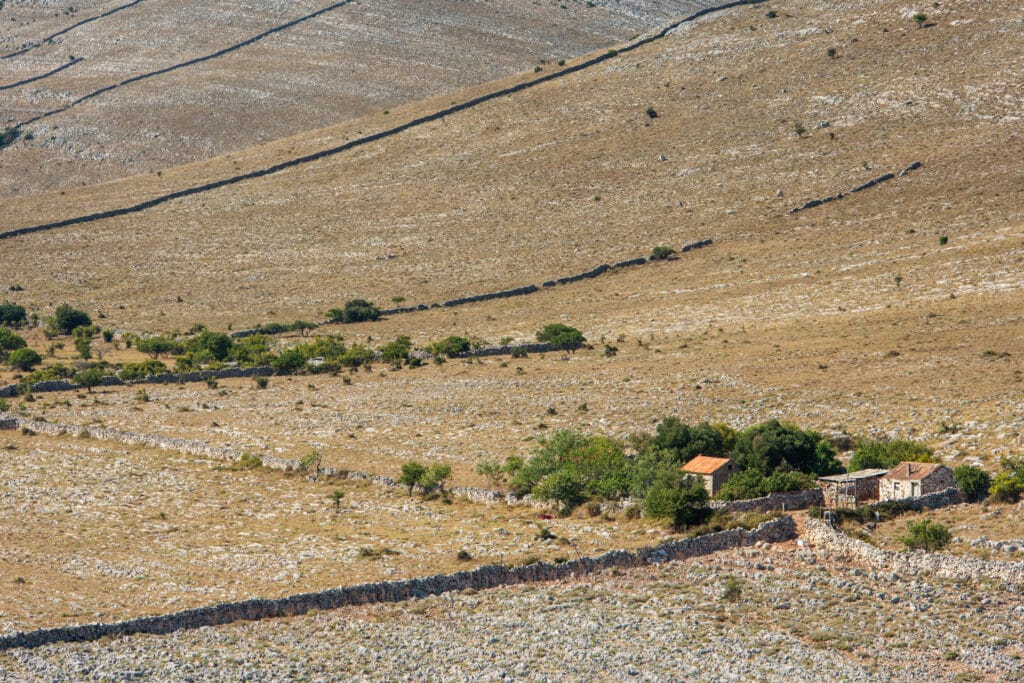
No matter how you arrive at the Kornati archipelago, make sure you allow yourself enough time to discover the extremely unique beauty of the islands. That beauty is primarily natural, of course. However, the ways in which humans have interacted with the rugged nature of the islands will impress everyone.
Since time immemorial, the local inhabitants have kept their sheep on the islands in the archipelago. There is evidence of sheep on Kornati from almost 5000 years ago. They appear quite bare, without any trees. However, numerous types of grass grow there and cover the ground and sheep enjoy them so much. And, to keep the sheep from mixing too much, so that each owner would have their sheep on their property, they built the dry stone walls. Since the islands are mostly long and narrow, the walls used to go all the way from one coast to the other. The amazing parallel walls are still an amazing sight to see. There is around 330 km of walls, in various conditions these days, within the Kornati National Park.
Crowns (steep cliffs)
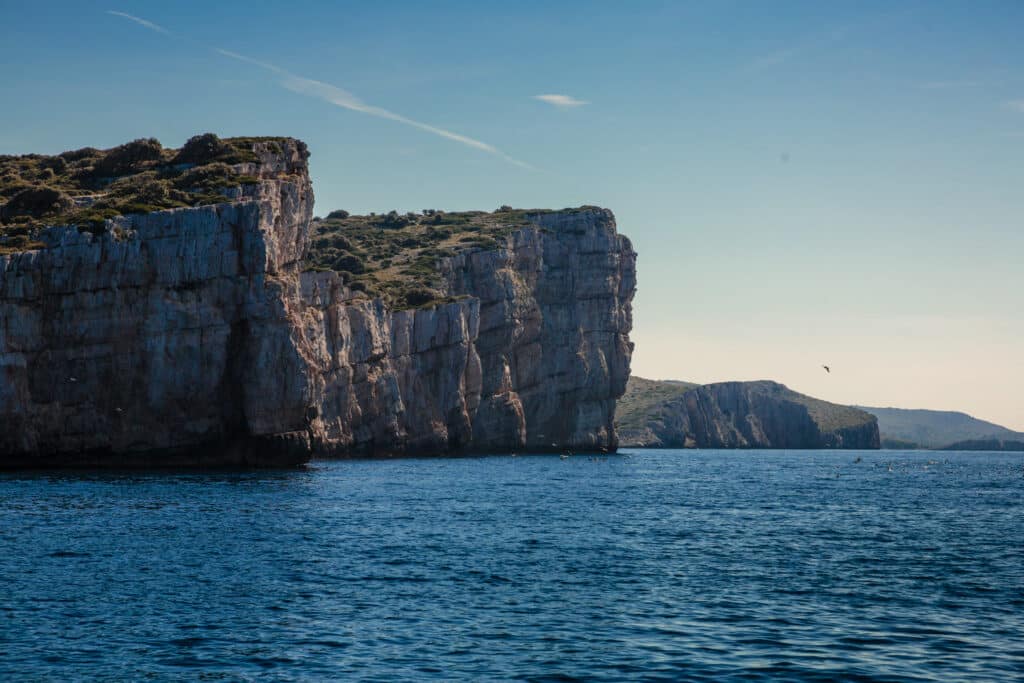
If you’ve seen one photo of an island from the Kornati archipelago, it was probably an amazing image of the steep cliff diving deep into the sea. The sides of the island facing the open sea have been sculpted by the waves for millennia. However, they serve as proof of seismic activity of this area, as the archipelago rose when the two tectonic plates collided.
The highest crown of the National Park (and the entire archipelago) is on Klobučar island, rising impressively 82 meters above sea level. The underwater portions of these geological marvels go up to 90 meters deep! The longest cliff on Kornati is on the Mana island, where 1350 meters of the 4.5 km of total coastline is one remarkable wall.
There are numerous types of birds nesting on the cliffs, so watch out for a peregrine falcon flying over your head. Climbing the cliffs is strictly prohibited, so please don’t do it. Also, don’t even think about jumping from the cliffs. However, there is a way for you to see the underwater world of the walls…
Diving
One of the key reasons the archipleago was protected as a national part was the underwater wealth around the islands. The sea around the archipelago is usually crystal clear and remarkably transparent. That’s why the light penetrates deep under the surface, so in addition to the amazing walls, there’s so much life to see underwater.
The corals are almost everywhere, it is one of the largest coralligenous habitats in Croatia. Many types of fish live near such walls, as they provide both shelter and food for the fish. There are several outstanding diving locations in the national park. However, keep in mind: you shouldn’t scuba-dive on your own within the park!
You need to have a permit and be accompanied by a licensed diving centre. Those are: Just Dive Croatia, Nadji Laguna, Najada, RC Tramonto, Diving Safari, Vranjak, Kornati Diving, Jadransko Ronjenje, Nautilus Sub. You do not need any type of permit nor are there any other types of limitations for snorkelling!
There are numerous diving sites in the Upper Kornati, outside of the National Park. Ask the diving centres about the option of diving there!
In Telaščica Nature Park, there are four locations where scuba diving is allowed. You also need to have a permit for the dives.
Piškera Island
The island of Piškera is extremely interesting because of its history. There are documents showing that back in 1824 there were 13 houses and depos for fish, salt and barrels on it. The owners of the island and the settlement were the fishermen from Sali on Dugi otok.
There are only 5 houses on the island today, (one of them is Jadra restaurant). However, remarkably, a small church built in 1560 is still standing! It was built for fishermen only, it’s one of a kind on the Adriatic, and its size is also notable: only 15 x 8 meters! The settlement on Piškera is across the narrow channel from Piškera ACI Marina, so make sure you go visit!
Tickets, fees and entrance to the Kornati National Park
In order to enter the Kornati National Park, you need to have a valid ticket. You can buy tickets at the National Park office on Murter, in numerous selling points in mainland towns from which most of the traffic to Kornati originates, online (NP Kornati webshop, Parkovi Hrvatske webshop, mySea webshop) and within the park itself.
You can buy the tickets for Telašćica Nature Park at those locations as well (Nature Park Telašćica webshop)
Keep in mind that buying the ticket when you’re already there, in the park, will cost you double than buying it in advance. The prices depend on the size of your vessel, the length of your stay (1, 3 or 5 days) and the time of year (the price is double in June, July, August and September). 1-day ticket for a 23-foot vessel in April is going to cost you 150 kunas, while 5 days for an over-246-foot vessel in August will set you back 27.000 kunas!
The tickets for day trips to Kornati, starting from the mainland, also include the price of individual admission to the National Park .
Where to stay in and around Kornati
It really shouldn’t surprise anyone that there isn’t an abundance of accommodation within Kornati National Park. Of course, there are no hotels on any of the islands. Additionally, the national park website lists only 6 licensed providers of private accommodation in the park. All six of them are on the Kornat island itself, and you can find their list here.
If you’re looking for accommodation somewhere on the mainland or on Murter, that’s probably a good idea. It will give you the opportunity to visit Kornati and stay close to the national park, while still providing more options and more affordable prices. Same goes for the islands of Dugi otok, Pašman and Ugljan.
(function(d, sc, u) {
var s = d.createElement(sc), p = d.getElementsByTagName(sc)[0];
s.type = ‘text/javascript’;
s.async = true;
s.src = u + ‘?v=’ + (+new Date());
p.parentNode.insertBefore(s,p);
})(document, ‘script’, ‘//aff.bstatic.com/static/affiliate_base/js/flexiproduct.js’);
There is only one campsite within the Kornati National Park. It is located on the Levrnaka island, a short walk away from the amazing Lojena beach, the only sandy beach in the archipelago. It can host 30 people in 10 tents, and the owners are really not working hard on marketing their existence.
There are more than 20 campsites on the Murter island, which might be a good solution for those who enjoy camping and want to be close to Kornati.
Where to eat in Kornati
There aren’t many locations in Croatia with a higher concentration of exquisite restaurants than Kornati. Obviously, numerous nautical tourists visiting and wanting to enjoy their meals in this unique environment lead to the opening of so many top restaurants on the islands. There are around 20 restaurants total on the Kornati islands. Most of them offer seafood and meat specialities, almost exclusively locally sourced. Some restaurants are traditional konobas, where the food is also prepared traditionally and without much innovation.
Other restaurants take their offer to a whole new level, using the premier local ingredients to create contemporary high-end meals. One restaurant probably stands out somewhat in that context, and that is the Fešta restaurant on the island of Žut, outside of the National Park. Read all about the experience of visiting Fešta in an article by our own Paul Bradbury. See what other tourists had to say about the various restaurants in Kornati.
Most, if not all restaurants on the Kornati islands offer their guests mooring during their meals. None of the restaurants is primarily looking at the on-the-budget travellers, as it is the higher-paying clientele who are their usual customers. You can expect to see actual luxury items on the menus (with appropriate luxury prices) in many of the restaurant. Stories are often told all over Croatia of extremely rich people who spend entire fortunes in restaurants while sailing on Kornati.
Kayaking, cycling, SUP in Kornati National Park
If you’re the kind of person who enjoys spending their time actively and using their body to create experiences, Kornati are a place for you. In addition to already mentioned scuba diving, snorkelling and hiking, there are numerous additional active ways to experience the sea around the Kornati and the amazing islands. Numerous providers offer well-organized one- or multi-day trips, starting from the mainland: Malik Adventures, Frontier Adriatic, SeaKayak Croatia…
3 things you should know about Kornati
A lot of history
The first confirmed colonisation of Kornati happened during the Illyrian times, in the neolithic period. The ruins of the Illyrian forts found in several locations on Kornat confirm that proposition. You can see quite a few Roman ruins on Kornati, including several Roman villas. The Byzantine era left us the Tureta fortress on the Kornat island, probably built in the sixth century AD. It was probably used as a watch fort, and its inaccessible position is probably why it’s still in such good condition today: there weren’t many people around, who would want to take the stone from the fortress to build their own houses! On the Lavsa island, during very low tide, you’ll be able to see the remains of the saltworks from the 14th century – these days almost completely submerged, proving the continued rise of the sea surface.
Vela Ploča or Magazinova Škrila on the island of Kornat
You can find an extremely odd bit of geology on the Kornat island. It’s actually a large limestone plate, of the size of approximately 2 football fields, near the highest peak of the Kornat island (Metlina, 237 m). The soil seems to have slipped off from the limestone plate, towards the coast, leaving the white, almost mirror-like surface behind. You can still see the slippage of the soil from the air, and the plate itself feels somewhat magical.

Its unusual appearance has contributed to the folk tale of the plate being created by the fairies so they can dance there. While the tale is probably not true if you ever do visit Vela Ploča, watch out, you never know when fairies might surprise you!
12 Crosses on the Kornat Island
The island of Kornat was the location of one of the biggest peace-time disasters in the modern Croatian history. On August 30, 2007, a group of firefighters was dispatched to the northern portion of Kornat, to put out a fire there. Out of 13 of them, 12 lost their lives on that day, while the sole survivor suffered horrible injuries. There has never been a well-accepted official explanation of what happened out there on that day. The circumstances which lead to such devastating loss of young lives are still hotly debated.
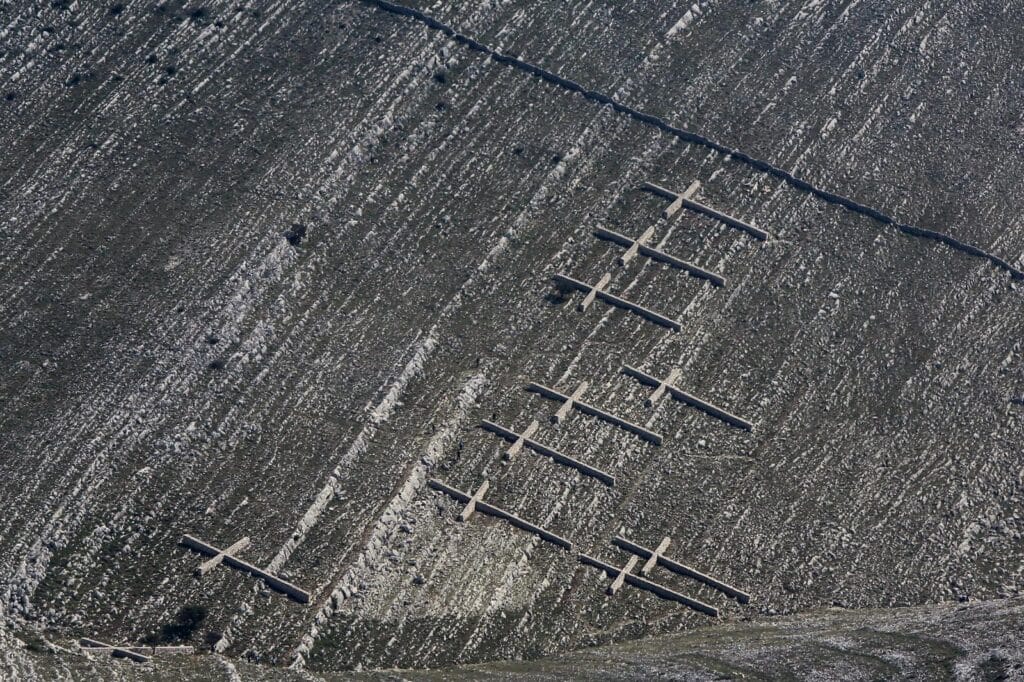
If you decide to hike in the Kornati islands, please respect the nature and the hard work of all the people who tried to rein the brutal environment with drywalls. If you, however, find yourself near the 12 crosses, pay special respect to them and their service. The crosses were hand-built, using the centuries-old technique of drywall. The idea for the memorial was by the famed Croatian architect Nikola Bašić.
More information
Kornati National Park Public Institution is located at Butina 2, 22243 Murter. You can find most service information about the National Park at their website.
Telašćica Nature Park Public Institution is located in Sali on Dugi otok. Check their website for more information.
To follow the latest news from Kornati, check out the dedicated TCN page.

